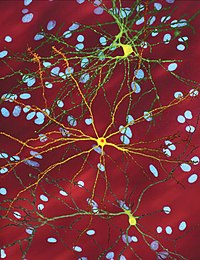
Photo from wikipedia
BackgroundClinician-rated measures of functioning are often used as primary endpoints in clinical trials and other behavioral research in Huntington disease. As study costs for clinician-rated assessments are not always feasible,… Click to show full abstract
BackgroundClinician-rated measures of functioning are often used as primary endpoints in clinical trials and other behavioral research in Huntington disease. As study costs for clinician-rated assessments are not always feasible, there is a question of whether patient self-report of commonly used clinician-rated measures may serve as acceptable alternatives in low risk behavioral trials.AimThe purpose of this paper was to determine the level of agreement between self-report and clinician-ratings of commonly used functional assessment measures in Huntington disease.Design486 participants with premanifest or manifest Huntington disease were examined. Total Functional Capacity, Functional Assessment, and Independence Scale assessments from the Unified Huntington Disease Rating scale were completed by clinicians; a self-report version was also completed by individuals with Huntington disease. Cronbach’s α was used to examine internal consistency, one-way analysis of variance was used to examine group differences, and paired t tests, kappa agreement coefficients, and intra-class correlations were calculated to determine agreement between raters.ResultsInternal consistency for self-reported ratings of functional capacity and ability were good. There were significant differences between those with premanifest, early-, and late-stage disease; those with later-stage disease reported less ability and independence than the other clinical groups. Although self-report ratings were not a perfect match with associated clinician-rated measures, differences were small. Cutoffs for achieving specified levels of agreement are provided.ConclusionsDepending on the acceptable margin of error in a study, self-reported administration of these functional assessments may be appropriate when clinician-related assessments are not feasible.
Journal Title: Journal of Neurology
Year Published: 2018
Link to full text (if available)
Share on Social Media: Sign Up to like & get
recommendations!